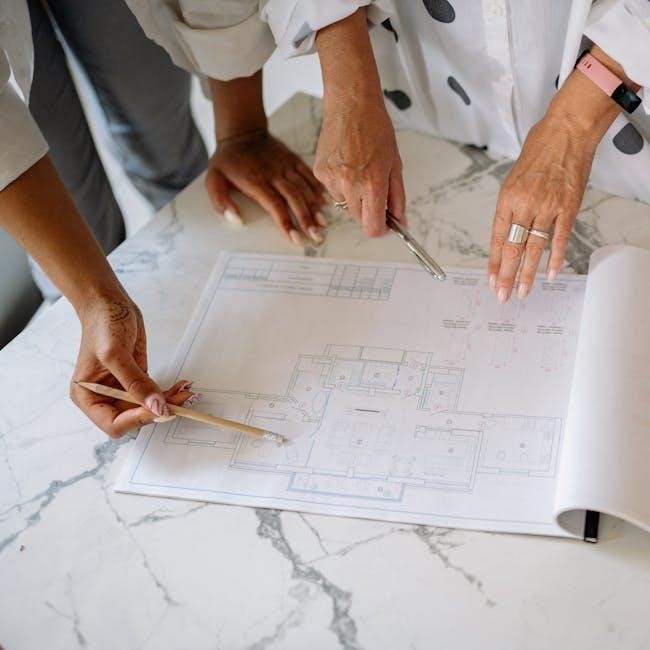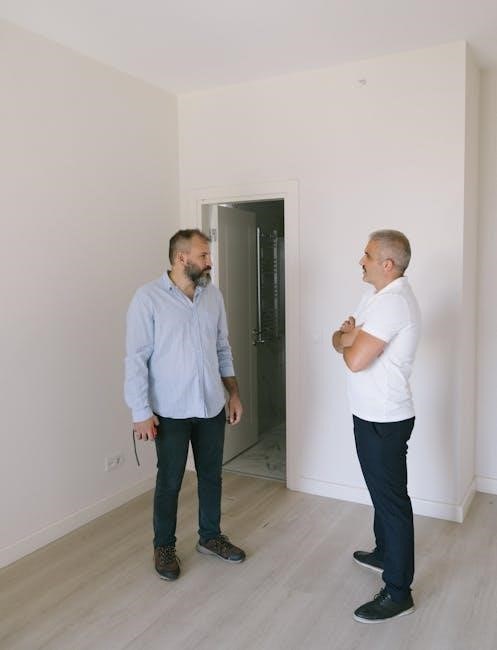Articulating design decisions is crucial for aligning stakeholders and ensuring project success. This skill helps designers communicate their rationale clearly, fostering collaboration and trust. Downloadable resources, like templates from Tom Greever’s book, provide practical tools to master this essential ability, ensuring designs resonate with both users and decision-makers effectively.
Overview of the Book “Articulating Design Decisions”
Articulating Design Decisions, written by Tom Greever, is a practical guide that equips designers with the skills to effectively communicate their design rationale. The book focuses on principles, tactics, and actionable methods for presenting designs in a way that resonates with stakeholders. It emphasizes the importance of clarity, empathy, and confidence in design discussions, ensuring that designers can justify their decisions and align teams around a shared vision. Greever provides insights into understanding stakeholder perspectives, preparing for presentations, and handling feedback constructively. The book also includes free downloadable resources, such as templates and worksheets, to help designers apply its teachings. By mastering the techniques outlined, designers can foster collaboration and drive projects toward success, ultimately creating better user experiences.
The Importance of Communicating Design Rationale
Effectively communicating design rationale is vital for project success, as it bridges the gap between creative vision and stakeholder understanding. Clear communication ensures that design decisions align with user needs and business goals, preventing misinterpretations that could derail projects. When designers articulate their rationale persuasively, they build trust and credibility, demonstrating their expertise and thought process. This fosters collaboration and secures buy-in from stakeholders, who are more likely to support designs they understand and value. Moreover, strong communication skills empower designers to address feedback constructively, turning criticism into opportunities for improvement. Ultimately, the ability to clearly express design decisions is as crucial as the design itself, ensuring that the final product meets both user expectations and stakeholder objectives effectively.
Key Themes and Objectives of the Book
The book Articulating Design Decisions focuses on empowering designers with the skills to communicate their work effectively. Its primary objective is to provide actionable strategies for presenting design rationale, ensuring stakeholders understand and support the decisions behind a design. Key themes include mastering the art of clear communication, understanding stakeholder perspectives, and preparing for design discussions. The book also emphasizes the importance of confidence, empathy, and collaboration in design conversations. By offering practical tools and real-world examples, it aims to help designers align their work with user needs and business goals. Ultimately, the book seeks to transform how designers present their ideas, fostering a culture of open dialogue and mutual understanding. These principles are supported by downloadable resources, such as templates and worksheets, to aid in applying the concepts effectively.

Understanding the Challenges of Design Communication
Designers often struggle to articulate their decisions to non-designers, making it difficult to gain stakeholder buy-in. Poor communication can lead to misalignment and hinder project success significantly.
Why Designers Struggle to Articulate Their Decisions
Designers often find it challenging to articulate their decisions because they are typically trained in creativity, not communication. Many struggle to translate their intuitive design process into logical, persuasive language that resonates with non-designers. This gap arises because designers may focus on aesthetics or functionality without considering how to align their decisions with stakeholders’ priorities. Additionally, the ability to communicate effectively is not always prioritized in design education, leaving many professionals unprepared for high-stakes discussions. Without a clear framework, designers may fail to convey the rationale behind their work, leading to misunderstandings and lack of buy-in. This disconnect can hinder collaboration and ultimately affect project outcomes, emphasizing the need for structured strategies to improve communication skills. Resources like Tom Greever’s book provide actionable methods to address these challenges and enhance articulation abilities.
The Impact of Poor Communication on Project Success
Poor communication of design decisions can significantly hinder project success. When stakeholders do not understand the rationale behind a design, it can lead to misalignment, delays, and even project failure. Without clear articulation, designers risk losing credibility and trust, making it difficult to gain buy-in from key decision-makers. This can result in unnecessary iterations, scope creep, and increased costs. Moreover, poor communication can lead to a lack of user-centered outcomes, as stakeholder priorities may not align with the intended user experience. Effective communication ensures that design solutions meet both user needs and business goals, emphasizing the critical role of articulation in achieving successful project outcomes. The consequences of poor communication underscore the importance of developing strong articulation skills to avoid these pitfalls and foster collaboration.
Stakeholder Perspectives and Their Role in Design Decisions
Stakeholders bring diverse perspectives and priorities to design projects, influencing outcomes significantly. Understanding their values and expectations is crucial, as their buy-in often determines success. The book emphasizes the importance of aligning design decisions with stakeholder goals, leveraging tools like the Stakeholder Values Worksheet to clarify priorities. By addressing their concerns and incorporating their feedback, designers can create solutions that resonate with both users and decision-makers. Effective communication strategies, as outlined in the book, help bridge gaps between design intent and stakeholder expectations, ensuring that everyone is aligned toward a common objective. This alignment is essential for delivering designs that meet business needs while enhancing user experiences. The book provides actionable methods to engage stakeholders meaningfully, fostering collaboration and mutual understanding throughout the design process.

Key Principles for Effective Design Communication
Effective design communication relies on clarity, confidence, and empathy. Designers must present ideas succinctly, convey conviction, and understand stakeholder needs to foster alignment and collaboration. These principles ensure designs resonate with both users and decision-makers, driving successful outcomes.
Clarity and Conciseness in Presenting Design Ideas
Clarity and conciseness are essential when presenting design ideas. Designers must avoid overwhelming stakeholders with unnecessary details; Instead, they should focus on key messages and user-centric benefits, ensuring that the core rationale behind their decisions is easily understood. By simplifying complex concepts and eliminating distractions, designers can guide stakeholders toward a shared understanding. This approach not only builds trust but also fosters productive discussions. Additionally, using visual aids and prototypes can help convey ideas more effectively, making the design process transparent and accessible to non-designers. Ultimately, clarity and conciseness empower designers to communicate their vision with precision, leading to better alignment and project success.
Confidence and Conviction in Design Discussions
Confidence and conviction are vital when discussing design decisions. Designers must present their work with assurance, demonstrating a clear understanding of the rationale behind their choices. This doesn’t mean being rigid; instead, it’s about showing that decisions are informed and user-focused. Stakeholders are more likely to trust a designer who can articulate their process and vision with certainty. Confidence also helps navigate challenging conversations, as it conveys expertise and credibility. By standing firmly behind their decisions while remaining open to feedback, designers can lead discussions effectively, ensuring that the design’s intent and value are clearly communicated. This balance of conviction and collaboration is key to successful project outcomes.
Empathy and Understanding Stakeholder Needs
Empathy is central to effective design communication, as understanding stakeholder perspectives ensures alignment with project goals. Designers must empathize with diverse viewpoints, recognizing that stakeholders may have differing priorities and concerns. By actively listening and acknowledging their needs, designers can tailor their communication to address these interests. This fosters a collaborative environment where stakeholders feel heard and valued. Tools like stakeholder values worksheets can help identify and prioritize these needs, ensuring that design decisions resonate with the broader team. Ultimately, empathy bridges the gap between design intent and stakeholder expectations, leading to more cohesive and successful outcomes. This approach not only enhances communication but also strengthens trust and cooperation within the team.
Preparing for Design Presentations
Effective preparation involves anticipating questions and structuring your presentation to address stakeholder concerns. Use frameworks and templates to organize your thoughts, ensuring clarity and confidence in your delivery.
Researching Stakeholder Values and Priorities
Understanding stakeholder values and priorities is critical for aligning design decisions with organizational goals. By researching their needs, designers can tailor presentations to address specific concerns and expectations. Tools like stakeholder values worksheets help identify key priorities, ensuring designs resonate with decision-makers. This step also involves gathering insights into user experience and business objectives, enabling designers to present solutions that balance both. Effective research fosters a deeper connection with stakeholders, making it easier to communicate the rationale behind design choices. The goal is to create a shared understanding, ensuring everyone is aligned toward achieving the best possible outcome for users and the organization alike.
Anticipating Questions and Concerns
Anticipating questions and concerns is a vital step in preparing for design presentations. By understanding potential stakeholder inquiries, designers can address issues proactively. This involves identifying common concerns, such as usability, cost, or alignment with business goals. Preparing clear, concise talking points ensures confident responses. Additionally, creating a structured presentation framework helps highlight key points, reducing the likelihood of misunderstandings. Tools like stakeholder values worksheets can guide this process, ensuring alignment with priorities. Addressing concerns early fosters trust and collaboration, making it easier to gain stakeholder buy-in. By anticipating questions, designers demonstrate thorough preparation and a user-centered approach, ultimately strengthening their case and ensuring smoother communication.
Creating a Structured Presentation Framework
A well-organized presentation framework is essential for effectively communicating design decisions. It ensures clarity and alignment with stakeholder priorities. Begin with a clear agenda, outlining key discussion points. Use design meeting templates to structure your approach, ensuring consistency and focus. Highlight the problem statement, design goals, and user needs upfront. Visual aids and prototypes can be integrated to illustrate key concepts. Anticipate questions and prepare concise responses to address potential concerns. Align the presentation with stakeholder values, emphasizing benefits and user experience. A structured framework not only enhances understanding but also builds confidence in the design rationale. By organizing your approach, you create a seamless and professional presentation that resonates with your audience and drives decision-making.

Strategies for Presenting Design Decisions
Effective strategies involve clarity, empathy, and visual aids to convey design rationale. Focus on user benefits, anticipate questions, and use prototypes to facilitate collaborative discussions and alignment.
Focusing on User Experience and Benefits
Emphasizing user experience and benefits is central to effective design communication. Designers should highlight how their decisions improve usability, accessibility, and overall satisfaction. By framing choices around user needs, designers create a compelling narrative that resonates with stakeholders. This approach ensures that discussions remain focused on the end-user, fostering alignment and support. Tools like prototypes and visual aids can demonstrate these benefits, making the rationale behind design decisions clear and relatable. Ultimately, a user-centric approach not only justifies design choices but also builds trust and credibility with stakeholders, leading to more successful project outcomes;
Using Visual Aids and Prototypes Effectively
Visual aids and prototypes are powerful tools for articulating design decisions. They allow designers to convey complex ideas in a tangible, accessible way, making it easier for stakeholders to understand and engage with the design. Wireframes, mockups, and interactive prototypes can illustrate user flows and key features, while visuals like charts and diagrams can highlight data-driven decisions. By presenting these elements clearly, designers can focus discussions on the user experience and intended outcomes. Prototypes, in particular, enable stakeholders to interact with the design, fostering a deeper understanding of the rationale behind it. Effective use of these tools not only enhances communication but also builds confidence in the design’s validity and alignment with project goals.
Facilitating Collaborative Discussions
Facilitating collaborative discussions is a cornerstone of effective design communication. By creating an open and inclusive environment, designers can encourage stakeholders to share their perspectives and concerns. Active listening and empathy are key to understanding diverse viewpoints, ensuring that all voices are heard. Designers should guide the conversation to stay focused on user-centered goals, using techniques like brainstorming sessions or structured agendas to maintain productivity. Collaboration fosters a shared sense of ownership and alignment, which is critical for successful project outcomes. By engaging stakeholders in meaningful dialogue, designers can address challenges collectively and build consensus around design decisions. This approach not only strengthens team dynamics but also ensures that the final product meets both user needs and business objectives effectively.

Handling Feedback and Criticism
Staying open-minded to stakeholder input is essential. Address concerns with clear data and logic, fostering constructive dialogue to reach mutually beneficial solutions.
Remaining Open-Minded to Stakeholder Input
Remaining open-minded to stakeholder input is vital for effective design communication. It involves actively listening to feedback and considering diverse perspectives without becoming defensive. Empathy plays a crucial role in understanding stakeholder needs and concerns, allowing designers to address them thoughtfully. By fostering a collaborative environment, designers can turn criticism into opportunities for improvement. This approach not only enhances the design process but also strengthens relationships with stakeholders. Data-driven responses and logical explanations help validate decisions while maintaining openness to constructive suggestions. Ultimately, embracing stakeholder input ensures that designs align with user needs and project goals, leading to more successful outcomes.
Addressing Concerns with Data and Logic
Addressing concerns with data and logic is essential for building credibility and trust in design decisions. By grounding discussions in empirical evidence, such as user research or usability testing, designers can objectively validate their choices. Logical reasoning helps stakeholders understand the rationale behind design decisions, reducing subjectivity. This approach fosters a collaborative environment where feedback is addressed systematically; Data-driven explanations also demonstrate a designer’s expertise and commitment to user-centered solutions. When concerns arise, presenting clear, fact-based arguments ensures that decisions align with project goals and user needs, ultimately leading to better outcomes and stakeholder satisfaction.
Negotiating and Finding Common Ground
Negotiating and finding common ground is a vital skill for designers to ensure alignment with stakeholders. By actively listening to concerns and balancing diverse perspectives, designers can identify mutually beneficial solutions. This involves compromising when necessary while maintaining the integrity of the design. Techniques like prioritizing and trade-off analysis help focus on high-impact decisions. Designers should approach negotiations with empathy, seeking to understand stakeholder priorities and aligning solutions with shared goals. Effective negotiation fosters collaboration, builds trust, and ensures that design decisions resonate with both users and stakeholders. By framing discussions around user needs and project objectives, designers can navigate conflicts constructively and reach outcomes that satisfy all parties involved.
Case Studies and Real-World Applications
Real-world examples from the book illustrate how designers successfully articulated decisions, solving complex problems and aligning stakeholders. These case studies highlight practical strategies for clear communication and effective outcomes.
Successful Examples of Articulating Design Decisions

Tom Greever’s book provides insights into successful design communication through real-world examples. One notable case involves a designer who transformed stakeholder skepticism into approval by clearly articulating user-centric reasoning. By focusing on user benefits and addressing concerns with data, the designer aligned the team and delivered a cohesive product. Another example highlights how a structured presentation framework and visual aids helped convey complex ideas, ensuring stakeholders understood the design rationale. These examples demonstrate how effective communication strategies can turn design concepts into successful outcomes, emphasizing the importance of empathy, clarity, and confidence in design discussions.
Lessons Learned from Challenging Design Scenarios
Challenging design scenarios often reveal the importance of empathy and adaptability in communication. One key lesson is that understanding stakeholder perspectives is as critical as the design itself. Designers must anticipate objections and prepare data-driven responses to address concerns effectively. Active listening and open-mindedness are essential to avoid misalignment. Additionally, overcomplicating presentations can distract from the core design rationale, emphasizing the need for clarity. These challenges highlight the value of structured frameworks and visual aids in facilitating understanding. By learning from these scenarios, designers can refine their communication strategies, ensuring that their decisions are not only well-articulated but also widely supported. These insights underscore the transformative power of effective communication in design processes.

Industry-Specific Insights and Best Practices
Different industries require tailored approaches to articulating design decisions. For example, in software development, emphasizing user experience and iterative testing is crucial. Product designers must align their rationales with brand goals and manufacturing constraints. Meanwhile, brand designers focus on visual consistency and emotional resonance. Templates and worksheets from resources like Tom Greever’s book help adapt communication strategies to these contexts. By understanding industry-specific needs, designers can better anticipate stakeholder concerns and present solutions that resonate. This adaptability ensures that design decisions are not only well-communicated but also relevant to the unique challenges of each field, fostering alignment and driving successful outcomes across diverse sectors.
Tools and Resources for Design Communication

Downloadable templates and stakeholder values worksheets from Tom Greever’s book provide structured frameworks for effective design communication. These tools help designers organize their thoughts and present decisions clearly, ensuring alignment with project goals and stakeholder expectations.
Downloading and Using Templates from the Book
The book provides downloadable templates, such as Design Meeting Templates and Stakeholder Values Worksheets, available in Word, PDF, and Google Docs formats. These tools help structure design discussions, ensuring alignment with project goals. By using these templates, designers can save time and reduce anxiety during presentations. They offer a clear framework for organizing ideas, anticipating questions, and addressing stakeholder concerns effectively. The templates are adaptable to various project scales and design domains, making them versatile for different needs. Whether you’re preparing for a meeting or documenting design rationale, these resources empower designers to communicate confidently and collaboratively, leading to better outcomes and stronger stakeholder buy-in.
Utilizing Stakeholder Values Worksheets
Stakeholder Values Worksheets are invaluable for aligning design decisions with organizational goals. By identifying and prioritizing stakeholders’ values, designers can tailor their communication strategies. These worksheets guide users in documenting key priorities, ensuring that design rationales resonate with decision-makers. They help anticipate potential concerns, enabling designers to address them proactively. Available in multiple formats, including Google Docs, Word, and PDF, these tools facilitate collaboration. Regular use of these worksheets enhances stakeholder engagement, fostering a shared understanding of design objectives. They are particularly effective in complex projects with diverse stakeholders, ensuring that design solutions meet both user and business needs effectively.
Design Meeting Templates for Effective Communication
Design meeting templates are essential for structuring discussions and ensuring productive communication. These templates, available in formats like Google Docs, Word, and PDF, provide a clear framework for agendas, action items, and decision tracking. By organizing meetings with predefined sections, designers can guide conversations effectively, ensuring all voices are heard and key points are addressed. These templates also help in documenting outcomes, reducing misunderstandings, and maintaining accountability. Regular use fosters consistency and efficiency, saving time while enhancing collaboration. They are particularly useful for aligning teams and stakeholders, ensuring that design decisions are well-documented and aligned with project goals. These templates are a practical tool for facilitating successful design meetings and achieving desired outcomes.
Effective communication is vital for successful design outcomes. Continuous learning and practice in articulating decisions will enhance your ability to collaborate and lead. Foster open dialogue and prioritize user-centric approaches to drive meaningful results.
Reinforcing the Importance of Clear Communication
Clear communication is the cornerstone of successful design outcomes. It ensures that stakeholders understand the rationale behind design decisions, fostering alignment and trust. Without effective communication, even the most innovative designs can fail to gain support. Designers must learn to articulate their ideas persuasively, focusing on user benefits and business goals. Poor communication can lead to misinterpretation, delays, and project failure. By mastering this skill, designers can bridge the gap between creative vision and stakeholder expectations. Tools like templates and worksheets from resources such as Articulating Design Decisions provide practical guidance to enhance communication strategies. Ultimately, clear communication empowers designers to advocate for their work confidently and collaboratively.
Continuous Improvement in Design Articulation
Continuous improvement in design articulation is essential for long-term success. Designers must regularly refine their communication skills to address evolving stakeholder needs and project complexities. By reflecting on past presentations and incorporating feedback, designers can identify areas for growth. Resources like Articulating Design Decisions offer actionable methods to enhance these skills. Additionally, staying updated on industry trends and best practices ensures that communication strategies remain effective. Encouraging a culture of open dialogue within teams further fosters collaboration and learning. Over time, this dedication to improvement not only strengthens individual capabilities but also elevates the overall impact of design within an organization. Investing in continuous learning is vital for designers to articulate their decisions with clarity and confidence.
Encouraging a Culture of Open Dialogue in Teams
Fostering a culture of open dialogue within teams is vital for effective design communication. When team members feel comfortable sharing their thoughts, it promotes collaboration and innovation. Leaders should encourage active listening and create safe spaces for discussion. Regular design meetings and feedback sessions can help maintain this environment. Tools like stakeholder values worksheets and design meeting templates from resources like Articulating Design Decisions can guide these interactions. Encouraging empathy and understanding among team members ensures that diverse perspectives are valued. This open dialogue not only improves communication but also strengthens team cohesion and alignment. By prioritizing open dialogue, teams can address challenges more effectively and deliver designs that meet user needs.
